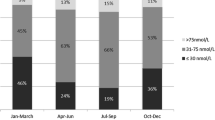Abstract
Investigations were carried out as to whether cytoprotective agents such as calcium antagonists can influence vitamin D induced nephrolithiasis. Increased vitamin D levels are found in 10–30% of all calcium oxalate stone formers. Male rats were assigned to one of the following groups: (1) 1,25-dihydroxycholecalciferol (DHCC) (n=8), (2) 1,25-DHCC+calcium antagonist Goe 6070 (a new 1,4-dihydronaphthyridine, Goedecke, Berlin) (n=8), or (3) control (n=8). 1,25-DHCC was administered for 6 days (120 pmol/24 h s.c.), Goe 6070 (1 mg/kg/24 h) by gavage. Clearance studies were performed on day 6. Kidneys were taken for histological examination and determination of calcium tissue content. 1,25-DHCC induced substantial concrement formation, which could be significantly limited by Geo 6070. The calcium tissue content was also reduced (0.17 vs. 0.04 mg/100 mg dry weight). 1,25-DHCC induced a dramatic fall in the glomerular filtration rate (GFR) (3.84 ml/min per kilogram). This reduction could be almost completely inhibited by the concomitant application of Goe 6070 (9.4 ml/min per kilogram; control 10.7 ml/min per kilogram). Goe 6070 did not influence the calcium handling. The results demonstrate a protective effect of Goe 6070 on vitamin D induced nephrolithias. The histological pattern (intracellular and membrane-bound concretions) and the fact that biochemical parameters were not influenced significantly by Goe 6070 indicate that cellular processes are important for 1,25-DHCC-induced nephrolithiasis.
Similar content being viewed by others
References
Baumann JM (1980) Pathophysiologie und medikamentöse Therapie der Phosphat-Stein-Erkrankung. In: Vahlensieck W (Hrsg) Urolithiasis, vol 4. Springer, Berlin Heidelberg New York, S 4
Bichler KH, Strohmaier WL (1988) Nephrocalcinosis, calcium antagonists and kidney. Springer, Berlin Heidelberg New York
Bichler KH, Strohmaier WL, Schreiber M, Korn S, Gaiser I (1984) Hyperkalziurie und Vitamin-D-Stoffwechsel. Fortscher Urol Nephrol 22:342
Boonen HCM, DeMey JGR (1990) Increased calcium sensitivity in isolated resistance arteries from spontaneously hypertensive rats. Effects of dihydropyridines. Eur J Pharmacol 179:403
Insogna KL, Broadus AE, Dreyer BE, Ellinson AS, Gertner JM (1985) Elevated production rate of 1,25-dihydroxyvitamin D in patients with absorptive hypercalciuria. J Clin Endocrinol Metab 61:490
Kleinschroth J, Hartenstein J, Mergelsberg I, Osswald H, Steinbrecher W, Wagner B, Weinheimer G, Satzinger G (1988) Novel 1,4-dihydro-1,6-naphthyridines as antihypertensive calcium antagonists. Abstr 10th Int Symp Med Chem Budapest
Osswald H, Steinbrecher W, Weinheimer G, Wagner B, Kleinschroth J, Hartenstein J, Satzinger G (1988) Antihypertensive activity of a novel calcium antagonist. Goe 5584-A, in rat models of hypertension. J Cardiovasc Pharmacol 12II [Suppl 6]:154
Osswald H, Weinheimer G, Kapp JF (1990) Renal actions of calcium channel antagonists. J Neural Transm 31 [Suppl]:39
Pak CYC (1978) Hypercalciurias. In: Pak CYC (ed) Calcium urolithiasis. Plenum Medical Book Co, New York, p 37
Scarpelli DG, Tremblay G, Pearse AGE (1960) A comparative cytochemical and cytological study of vitamin D induced nephrolithiasis. Am J Pathol 36:331
Schrier RW, Arnold PF, van Putten VJ, Burke TJ (1987) Cellular calcium in ischemic acute renal failure: role of calcium entry blockers. Kidney Int 32:313
Schwille PO, Brandt P, Ulbrich D, Kömpf W (1975) Pankreasinseln, Plasmaglukagon und renale Verkalkungen unter verschiedener Grunddiät bei der Rattte. Urologie A 14:306
Stapleton FB, Langman CB, Bittle J, Miller LA (1987) Increased serum concentrations of 1,25(OH)2 vitamin D in children with fastig hypercalciuria. J Pediatr 110:234
Strohmaier WL, Seeger D, Osswald H, Bichler KH (1992) Renal insufficiency induced by parathyroid hormone: influence of the calcium antagonist Goe 6070. Eur Urol 21:323
Thier SO (1978) Renal insufficiency and hypercalcemia. Kidney Int 14:194
Weinreich T, Merke J, Schönermark M, Diebold M, Haensch GM, Ritz E (1991) Actions of 1,25-dihydroxyvitamin D3 on human mesangial cells. Am J Kidney Dis 18:359
Wuthier RE, Rice GS, Wallace JEB, Weaver RL, LeGeros RZ, Eanes ED (1988) In vitro precipitation of calcium phosphate under intracellular conditions: formation of brushite from an amorphous precursor in the absence of ATP. Calcif Tissue Int 41:401
Author information
Authors and Affiliations
Rights and permissions
About this article
Cite this article
Strohmaier, W.L., Seeger, R.D., Osswald, H. et al. Reduction of vitamin D induced stone formation by calcium. Urol. Res. 22, 301–303 (1994). https://doi.org/10.1007/BF00297199
Received:
Accepted:
Issue Date:
DOI: https://doi.org/10.1007/BF00297199




